Ultimate Blueberry Thyme Focaccia Recipe: Sweet, Savory & Perfectly Simple
Prepare to elevate your baking game with a unique and absolutely irresistible creation: Blueberry Thyme Focaccia. This isn’t just any bread; it’s a delightful culinary adventure that marries the juicy sweetness of fresh blueberries with the earthy, aromatic notes of thyme, all baked into a wonderfully soft yet chewy Italian-style flatbread. Each bite offers a harmonious blend of sweet and savory, making it a showstopper at any meal.
Forget everything you thought you knew about traditional focaccia. While typically a savory staple, this version takes an unexpected turn, leveraging the natural sugars of blueberries which, when baked, transform into pockets of savory-sweet goodness. Paired with fragrant fresh thyme, the combination is nothing short of magical, creating an aroma that will fill your kitchen and entice everyone.
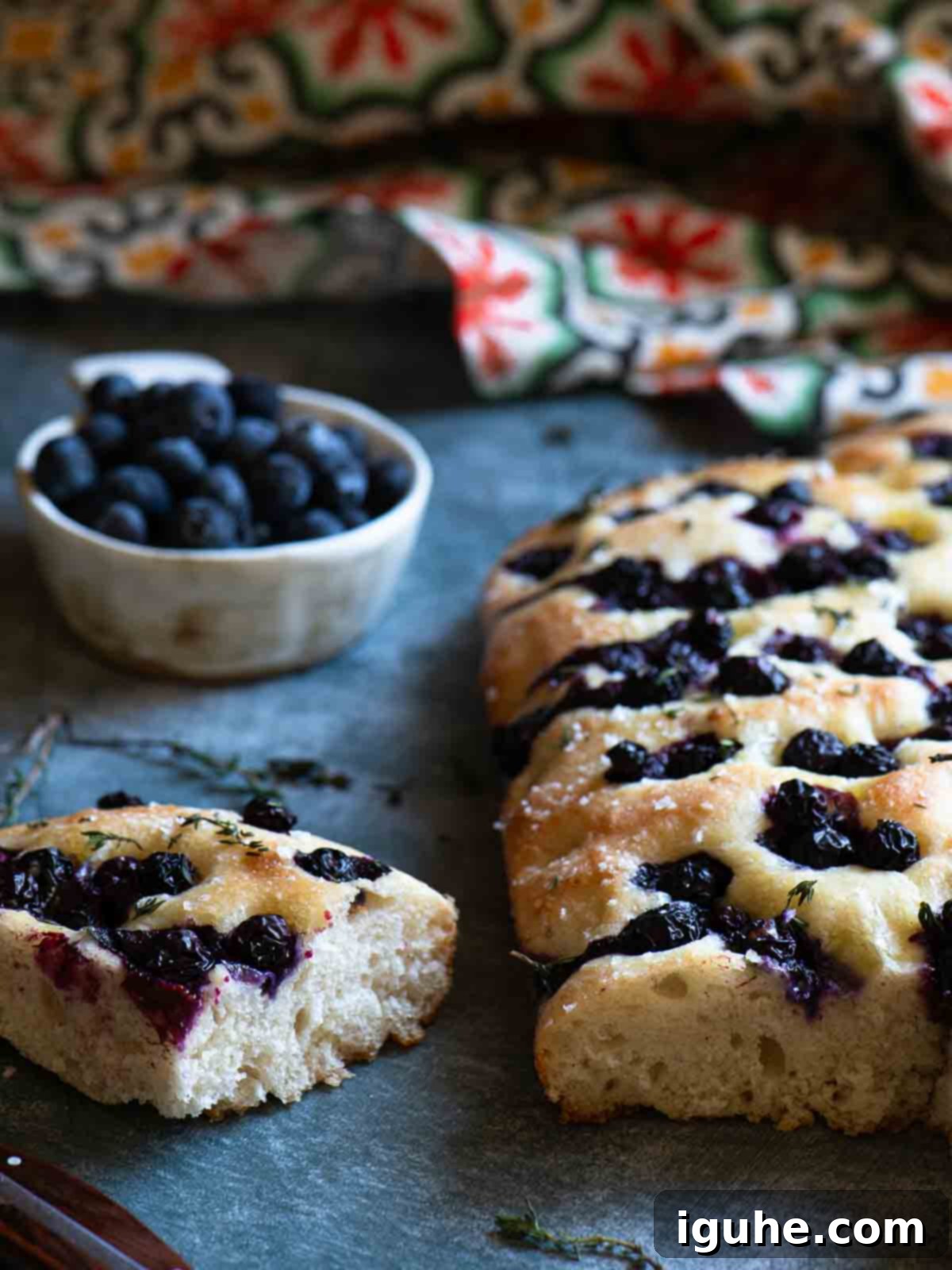
If the idea of baking with yeast makes you a little nervous, don’t worry! Focaccia, often compared to pizza in texture and style, is remarkably forgiving and much simpler to master. This particular blueberry and thyme focaccia recipe is perfect for beginners, as it can be easily made either by hand in a bowl or with the convenience of a stand mixer. We’ve included step-by-step guidance, complete with pictures, to ensure your success. Most of your “thyme” (pun intended!) will be spent simply waiting for the dough to rise, giving you plenty of time to relax while the magic happens.
Why You’ll Fall in Love with This Blueberry Thyme Focaccia
This recipe isn’t just about making bread; it’s about creating an experience. Here’s why this Blueberry Thyme Focaccia will quickly become a favorite:
- Unique Sweet & Savory Balance: The star of the show is the harmonious contrast between the sweet, juicy blueberries and the aromatic, slightly peppery fresh thyme. It’s a flavor profile that tantalizes the taste buds and works for any time of day.
- Incredibly Easy to Make: Unlike some intimidating bread recipes, focaccia is very forgiving. This specific recipe simplifies the process, making it accessible even for those new to baking with yeast. Whether you prefer kneading by hand or using a stand mixer, you’ll find the steps straightforward.
- Impressive Presentation: With its dimpled surface, vibrant blueberries, and flecks of green thyme, this focaccia looks as good as it tastes. It’s guaranteed to impress guests at brunch, dinner, or a casual get-together.
- Versatile Serving Options: Enjoy it warm from the oven as a delightful breakfast pastry, a light lunch, an elegant appetizer, or a flavorful side dish with your favorite savory meals. It pairs beautifully with cheese boards, roasted meats, or fresh salads.
- Wonderful Aroma: The moment this focaccia starts baking, your kitchen will be filled with an incredibly fragrant aroma of warm berries and herbs, creating an inviting and cozy atmosphere.
- Chewy and Flavorful Crust: Thanks to the bread flour and a generous drizzle of olive oil, you’ll achieve that coveted chewy interior and a delightfully crispy, golden-brown crust.
The Origins of Focaccia: A Brief Culinary History
Focaccia, pronounced “foh-KAH-chuh,” is a flat oven-baked Italian bread that has roots dating back to ancient times. Its name is derived from the Latin word “panis focacius,” meaning “hearth bread,” referring to how it was traditionally cooked in the embers of a fire. It is often seen as an ancestor to pizza, sharing a similar base and cooking method, but generally featuring a thicker, softer dough and a dimpled surface often brushed with olive oil and sprinkled with herbs and salt.
Historically, focaccia was a humble bread, a staple for farmers and laborers. It could be easily topped with whatever ingredients were on hand, from simple herbs and garlic to olives or cheese. Its adaptability is one of its enduring charms, allowing for countless variations, both savory and, as we’re exploring today, delightfully sweet and fruity. This rich history makes every bite of homemade focaccia feel like a connection to generations of Italian culinary tradition, reimagined with a modern, flavorful twist.
[feast_advanced_jump_to]Ingredient Notes & Smart Substitutions
Understanding your ingredients is key to successful baking. Here are some important notes and potential substitutions to help you perfect your Blueberry Thyme Focaccia:

- Bread flour: This type of flour is crucial for achieving the classic chewy, elastic texture of focaccia. It boasts a higher protein content (typically 12-14%) compared to all-purpose flour. This higher protein develops more gluten, which gives the bread its signature structure and bite. While you *can* use all-purpose flour in a pinch, expect a slightly less chewy result.
- Yeast (Active Dry): Active dry yeast consists of small, dehydrated granules that require rehydration and activation in warm liquid (a process called “proofing”) before being mixed into the main dough. We recommend using the convenient ready-made packets found in any supermarket. Each packet usually contains 2 ¼ teaspoons or 7 grams of yeast. For best results, always check the expiration date!
- Salt (Kosher or Fine Sea Salt): Salt is essential for flavor and also plays a vital role in regulating yeast activity. It helps to control the fermentation process, contributing to a better rise and more complex flavor. Avoid using table salt, which is often iodized and can have a metallic taste, and measure carefully.
- Sugar: A small amount of sugar acts as food for the yeast, helping to activate it and encourage a robust rise. It also contributes to the beautiful golden-brown color of the focaccia crust and subtly enhances the overall flavor.
- Water: The temperature of your water is critical when working with yeast. It should be warm, but definitely NOT hot. We highly suggest using a thermometer to ensure the ideal temperature range of 105°F to 115°F (41°C to 46°C). Water that is too hot will kill the yeast, preventing your dough from rising, while water that is too cool won’t properly activate it, resulting in a sluggish or failed rise.
- Blueberries: For this recipe, fresh blueberries are strongly recommended. Frozen blueberries contain a high water content which, when thawed and baked, can release too much moisture. This excess water can make the focaccia top soggy and prevent it from crisping up beautifully. If you absolutely must use frozen, do not thaw them; toss them directly into the dough just before the final rise and baking.
- Thyme: Fresh thyme leaves offer the best aroma and flavor for this dish, providing an earthy, slightly citrusy note that complements the blueberries perfectly. If fresh thyme isn’t available, you can use dried thyme leaves in a pinch, but remember that dried herbs are more concentrated, so use about one-third the amount of fresh.
- Olive Oil: A good quality extra virgin olive oil is non-negotiable for focaccia. It not only prevents sticking but also imparts a significant part of the bread’s characteristic flavor and richness, contributing to a crispy bottom crust and a tender crumb.
Step-by-Step Instructions for Perfect Blueberry Thyme Focaccia
Creating this delightful focaccia is simpler than you might think! Follow these simplified steps to guide you through the process. Remember, the full, detailed instructions are always available in the recipe card below.
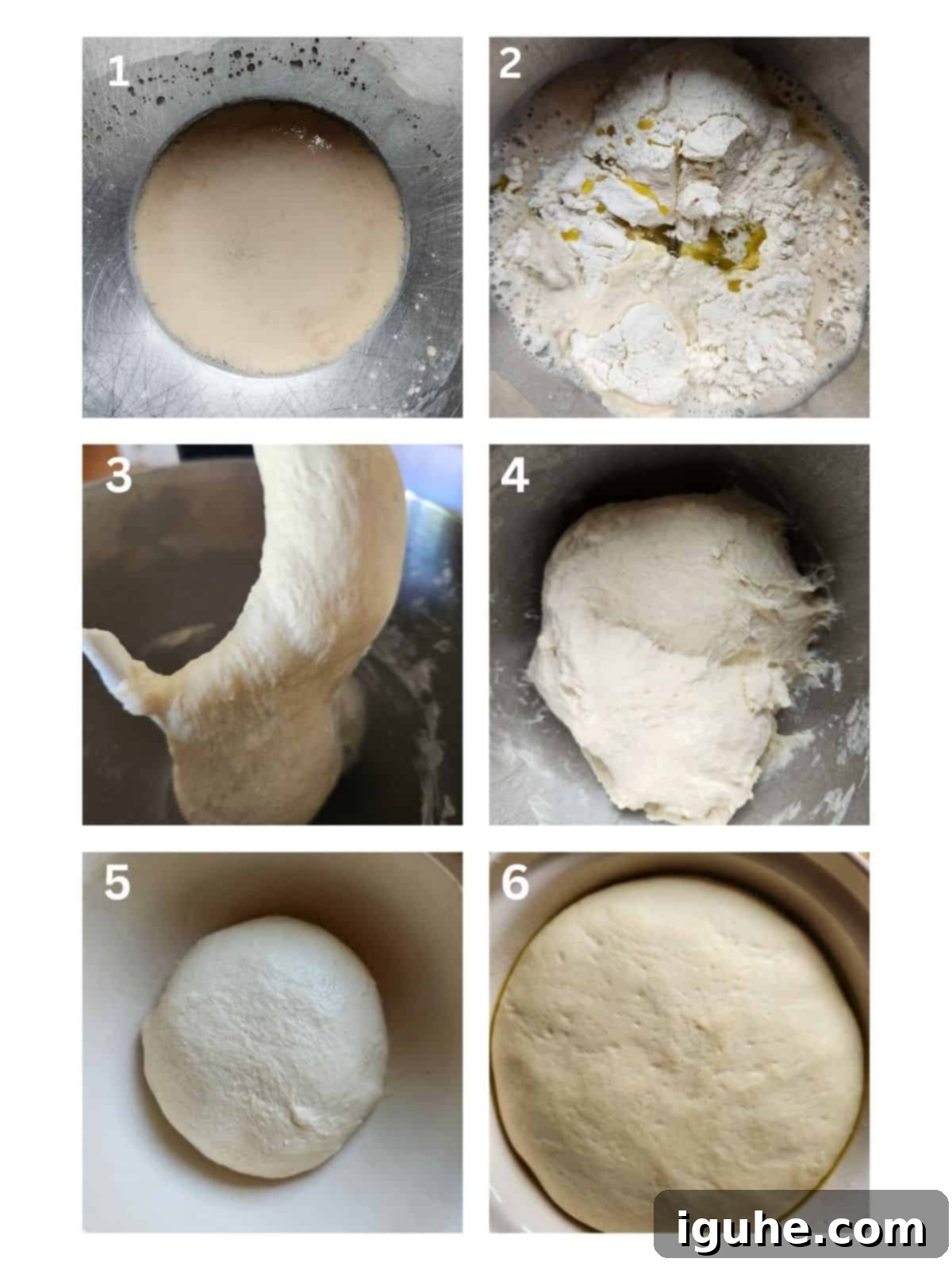
Step 1: Proof the Yeast. In a small bowl, combine the active dry yeast, a pinch of sugar, and a portion of the warm water. Stir gently and let it sit for about 5 minutes until a foamy layer forms on top. This indicates your yeast is active and ready to go!
Step 2: Combine Dry & Wet. In a stand mixer bowl (or a large mixing bowl if kneading by hand), add the bread flour, salt, a portion of the olive oil, and the remaining warm water. Once the yeast is proofed, pour it into the flour mixture.
Step 3-4: Mix the Dough. Mix on a low speed (or knead by hand) for 3-5 minutes until the dough comes together, forms a smooth ball around the dough hook, and pulls away cleanly from the sides of the bowl. If it feels too sticky, add a very small amount of flour at a time until it’s workable.
Step 5: Form & Coat. Remove the dough and give it a few quick kneads on a lightly floured surface, shaping it into a smooth, round ball. Lightly oil a clean large bowl, place the dough in, and flip it once to ensure both sides are coated with oil. This prevents it from sticking during the rise.
Step 6: First Rise. Cover the bowl with a damp towel or plastic wrap. Place it in a warm, draft-free spot (see pro tips for oven rising trick!) and let it rise for 1 to 1½ hours, or until it has visibly doubled in size. Patience is key here!
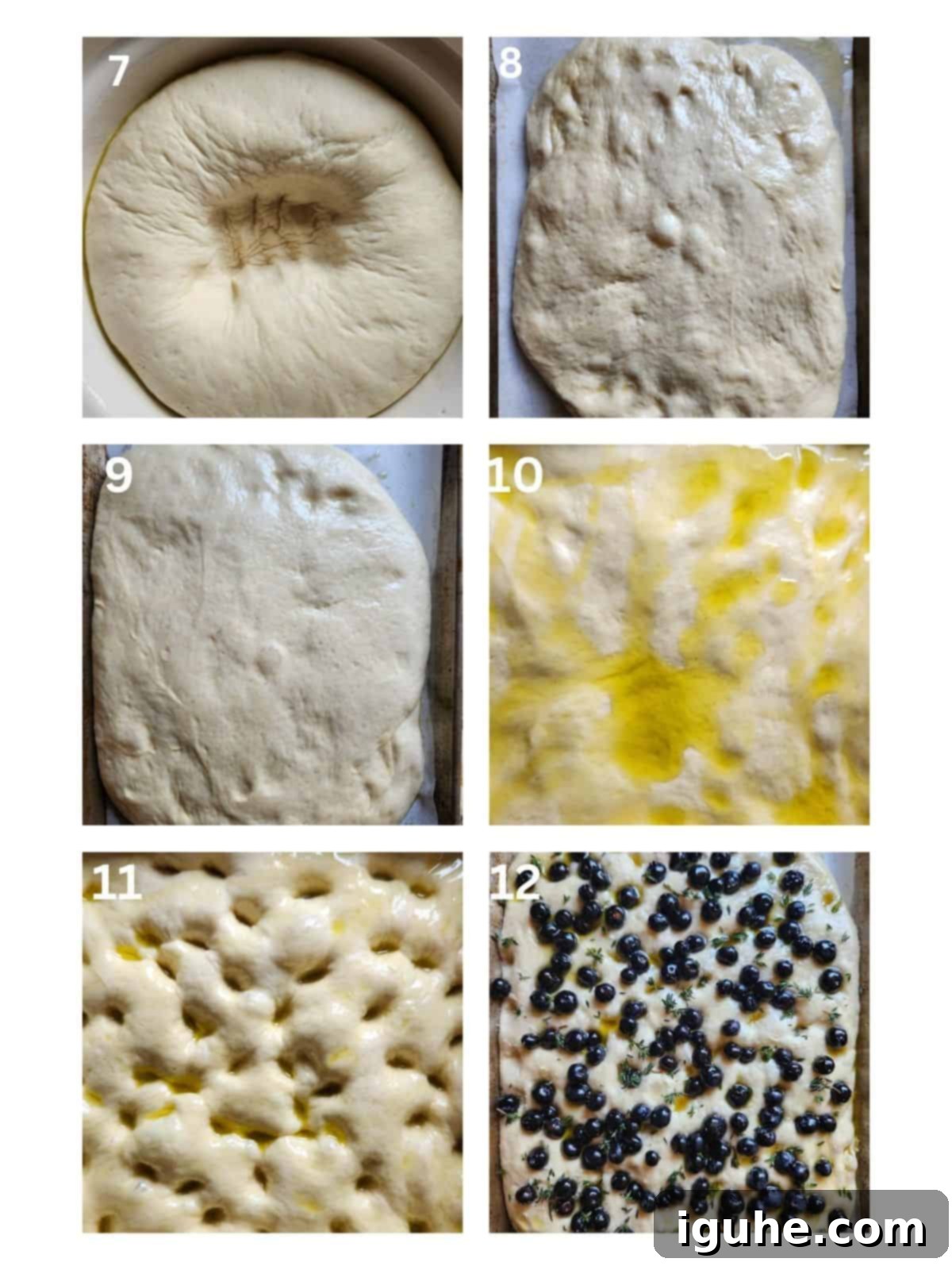
Step 7: Deflate the Dough. Gently punch down the risen dough in the center to release some of the air. This helps create a better texture and makes it easier to shape.
Step 8: Prep the Pan & Stretch. Line a 9×13 inch baking pan or quarter sheet pan with parchment paper, then pour half of the remaining olive oil into the bottom of the pan. Place the deflated dough in the pan and gently stretch it with your fingers until it nearly reaches all edges. Don’t force it; if it springs back, let it rest for 5 minutes and try again.
Step 9: Second Rise. Cover the pan again with a damp towel or plastic wrap and let the dough rise for another 30 minutes. This second rise is shorter but crucial for a light and airy texture.
Step 10: Oil the Top. Once the second rise is complete, uncover the dough and generously drizzle the remaining olive oil over the top surface. This helps create a crispy crust and adds flavor.
Step 11: Dimple the Dough. Using your fingertips, deeply poke holes all over the dough, pressing all the way down to the bottom of the pan. These dimples are characteristic of focaccia and create delightful little pockets for the olive oil and toppings.
Step 12: Add Toppings & Bake. Evenly scatter the fresh blueberries over the dimpled dough, followed by the fresh thyme leaves and a sprinkle of sea salt flakes. Bake in a preheated oven at 450°F (230°C) for 15-20 minutes, or until the focaccia is beautifully golden brown on top and cooked through. Serve warm and enjoy!
👩🍳 Pro Tips for Focaccia Perfection
- Precision with Water Temperature: As mentioned, yeast is sensitive! Always use a thermometer to accurately measure your warm water. The ideal range of 105°F to 115°F (41°C to 46°C) is crucial. Too hot, and you’ll kill the yeast; too cold, and it won’t activate properly, leading to a dense focaccia.
- Optimize Your Rising Environment: Yeast loves warmth! If your kitchen is cool, finding an ideal spot for the dough to rise can be tricky. A fantastic hack is to use your oven. Briefly preheat it to its lowest temperature (around 150-200°F or 65-93°C) for just a couple of minutes, then turn it OFF. Place your covered dough bowl inside the warm, turned-off oven and close the door. This creates a perfectly consistent, draft-free environment for optimal rising. I’ve had many failed doughs before adopting this simple trick!
- Invest in Quality Olive Oil: Focaccia gets a significant portion of its flavor from olive oil. Using a good quality, flavorful extra virgin olive oil will make a noticeable difference in the final taste and aroma of your bread. Don’t skimp here; it’s worth it!
- Allow Ample Rising Time: This recipe involves two rises, which are essential for developing flavor and achieving that characteristic airy, chewy texture. Don’t rush these steps! Plan ahead, especially if you’re making this for a specific event or crowd, to ensure the dough has sufficient time to double in size for both rises.
- Don’t Over-Flour: When kneading or handling the dough, use flour sparingly on your work surface and hands. Adding too much extra flour can make your focaccia dense and dry. A slightly sticky dough is often desirable for focaccia’s texture.
- Parchment Paper is Your Friend: Lining your baking pan with parchment paper makes for easy removal and cleanup. It also helps prevent the bottom of the focaccia from sticking, ensuring that perfect crispy base.
- Deep Dimples for Flavor Pockets: When you dimple the dough, don’t be shy! Press your fingers all the way down to the bottom of the pan. These deep indentations create wonderful pockets where the olive oil, blueberries, and thyme can pool, infusing every bite with maximum flavor.
Creative Variations to Explore
While the Blueberry Thyme Focaccia is fantastic as is, it’s also a wonderfully adaptable base for your culinary creativity. Feel free to experiment with different flavor combinations to suit your mood or what’s in season:
For a slightly different herbal twist, swap the fresh thyme for other complementary herbs:
- Basil: Adds a sweet, peppery, slightly minty note.
- Sage: Offers a warm, earthy, slightly piney flavor, great with the savory aspect of blueberries.
- Mint: Provides a bright, refreshing contrast, especially lovely for a summer focaccia.
- Rosemary: A classic focaccia herb that adds a pungent, woody aroma and flavor.
- Lavender: For a truly unique and delicate floral note, use food-grade or “culinary” lavender. Ensure to process the buds slightly so they are not whole, releasing their fragrant oils more effectively.
You could also make this focaccia with other types of fruit to create new sweet and savory sensations. Just ensure the fruit pieces are roughly the same size for even baking:
- Peaches: Sweet and juicy, they’ll create a lovely soft texture when baked.
- Strawberries: Offer a vibrant color and tart-sweet flavor.
- Blackberries: Deeply colored and tangy, they pair beautifully with many herbs.
- Plums: Provide a rich, slightly tart sweetness that works well in baked goods.
- Lemon Zest: A fantastic addition to any of the fruit variations, bringing a bright, zesty aroma and flavor that lifts the whole bread.
Don’t be afraid to mix and match! A combination of peaches and rosemary, or blackberries with a hint of lemon zest and mint, could be absolutely divine. The possibilities are endless when you start with such a versatile and delicious base.
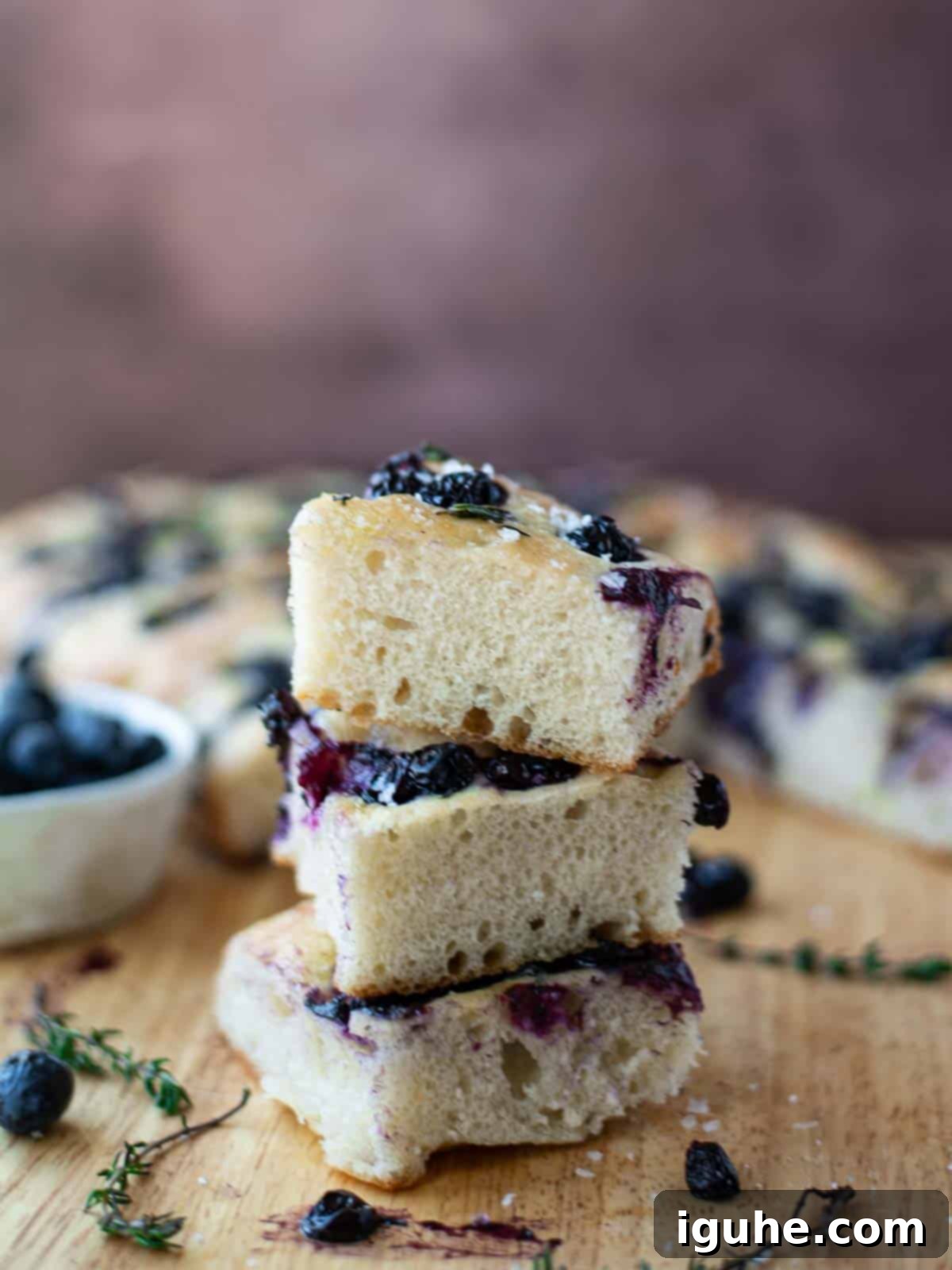
Serving Suggestions for Your Blueberry Thyme Focaccia
This versatile focaccia can be enjoyed in so many ways throughout the day. Its unique sweet and savory profile makes it suitable for almost any occasion:
- Breakfast or Brunch: Serve warm alongside a cup of coffee or tea. It’s fantastic on its own, but also pairs well with scrambled eggs, a side of bacon, or a dollop of Greek yogurt.
- Elevated Snack: A slice of this focaccia makes for a sophisticated and satisfying snack. Drizzle with a little extra olive oil or a touch of honey for added sweetness.
- Appetizer: Cut into small squares or triangles and serve as an appetizer at your next gathering. It’s a wonderful conversation starter and perfect with a glass of sparkling wine or a light cocktail.
- Side Dish: Surprisingly, this focaccia makes an excellent accompaniment to savory main courses. Try it with roasted chicken or pork, a fresh garden salad, or even a light pasta dish. The fruit and herb notes can complement a variety of flavors.
- Dessert (Light): While not overly sweet, it can serve as a light and refreshing dessert after a meal. The burst of warm blueberries provides a delightful, natural sweetness.
- Cheese Board Companion: The sweet and savory notes of this focaccia make it a perfect addition to a cheese board, especially with soft cheeses like goat cheese or brie.
Storage & Reheating Tips
To keep your Blueberry Thyme Focaccia fresh and delicious:
- Room Temperature: This fruity focaccia is best enjoyed fresh, but it can be stored at room temperature for 2-3 days. Make sure to wrap it tightly in plastic wrap or store it in an airtight container to prevent it from drying out. It will naturally become softer as it sits.
- Reheating: To bring back that glorious crispness and warm aroma, we highly recommend reheating it. Place slices in a 350°F (175°C) oven for about 8-10 minutes, or until warmed through and the crust is crisp again. You can also use a toaster oven for individual slices.
- Freezing for Longer Storage: If you’d like to enjoy your focaccia for longer, it freezes beautifully! Once completely cooled, wrap individual slices or the entire loaf tightly in plastic wrap, then again in aluminum foil. It can be stored in the freezer for up to 2-3 months.
- Reheating from Frozen: To reheat from frozen, unwrap the focaccia and place it directly into a preheated 350°F (175°C) oven. Bake for 15-20 minutes, or until heated through and crisp.
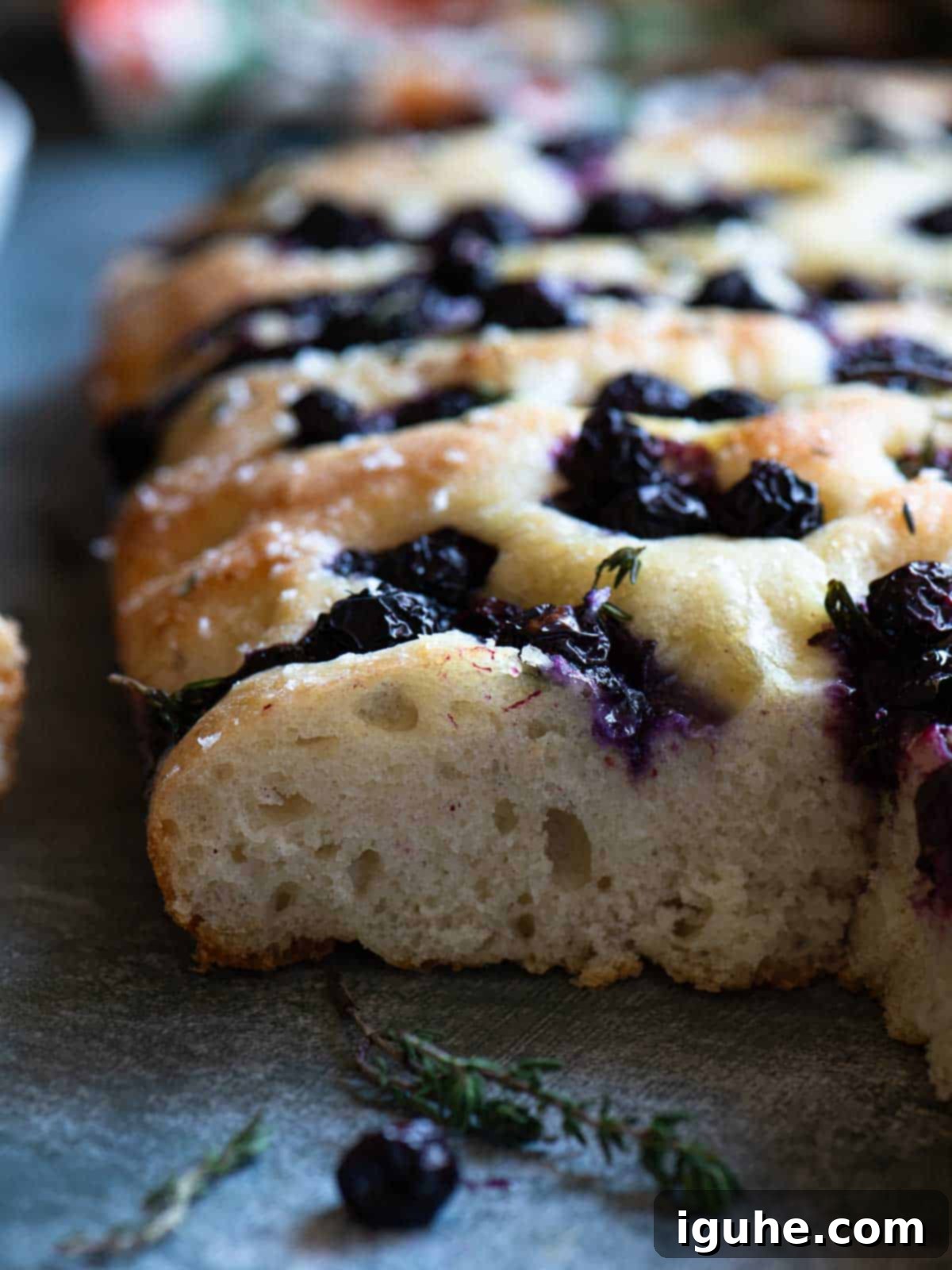
Troubleshooting Common Focaccia Problems
Even with an easy recipe, baking can sometimes throw a curveball. Here are solutions to common issues you might encounter:
- Dough Not Rising:
- Issue: Your yeast isn’t foamy after proofing, or the dough isn’t doubling in size.
- Solution: The most common culprits are inactive yeast (check expiration date) or incorrect water temperature (too hot kills it, too cold keeps it dormant). Ensure your water is in the 105-115°F range and your rising environment is warm and draft-free.
- Focaccia is Dense or Dry:
- Issue: The final bread lacks the airy, chewy texture.
- Solution: This can be due to not enough rising time, over-kneading (which tightens the gluten too much), or adding too much flour, especially during initial mixing or kneading. Be gentle with the dough, ensure proper rises, and avoid adding excessive flour.
- Focaccia is Too Sticky to Handle:
- Issue: The dough is excessively wet and difficult to form.
- Solution: While focaccia dough is meant to be a bit sticky and wet, if it’s unmanageable, you can gradually add a tiny bit more bread flour (a tablespoon at a time) until it’s easier to work with. Make sure your hands are lightly floured, not heavily.
- Blueberries or Thyme Burn During Baking:
- Issue: Toppings look burnt before the bread is golden.
- Solution: This might happen if your oven runs hot or if the focaccia is too close to the top heating element. Try baking on a lower rack or, if necessary, loosely tent the focaccia with aluminum foil during the last few minutes of baking to protect the toppings.
- Uneven Browning:
- Issue: One side of the focaccia is darker than the other.
- Solution: Ovens often have hot spots. Rotate your baking pan halfway through the baking time to ensure even browning.
Frequently Asked Questions About Blueberry Thyme Focaccia
Yes, absolutely! Instant yeast is a great alternative. The main difference is that instant yeast doesn’t require proofing. To use it, simply add it directly to your dry ingredients (flour, salt, sugar) and then proceed with adding the warm water and olive oil. You should also decrease the amount of instant yeast by about 25% compared to active dry yeast. So, for this recipe, you would use approximately 1¾ teaspoons of instant yeast.
We generally don’t recommend using frozen blueberries for this particular focaccia recipe. Frozen blueberries have a much higher water content than fresh ones. When they thaw and cook in the oven, they can release a lot of moisture, which might make the top of your focaccia soggy and prevent it from achieving that lovely crisp crust. If fresh blueberries are truly unavailable, you could try using frozen ones directly from the freezer (do not thaw), but be aware the texture might be different.
Yes, you can! Focaccia dough is quite amenable to an overnight cold ferment, which can even enhance its flavor. After the first rise (Step 6), instead of proceeding to the second rise, lightly punch down the dough, place it in an oiled bowl, cover it tightly with plastic wrap, and refrigerate it for 8-24 hours. When you’re ready to bake, remove the dough from the fridge about 1-2 hours before baking to allow it to come to room temperature and relax, then proceed with shaping, the second rise, topping, and baking as instructed.
A 9×13 inch baking dish (like a ceramic or glass casserole dish) or a quarter sheet pan (a metal baking sheet with sides, typically 9×13 or 9.5×13 inches) works perfectly for this recipe. If you prefer a thicker focaccia, you could use a slightly smaller pan, just adjust the baking time slightly. Always line your pan with parchment paper for easy removal and to prevent sticking.
More Delightful Blueberry & Thyme Recipes!
If you’ve fallen in love with the combination of blueberries and thyme, or simply can’t get enough of these incredible flavors, explore some of our other cherished recipes:
- Savory Lemon Thyme Popovers
- Refrigerator Blueberry Earl Grey Jam
- Acorn Squash Egg in a Hole with Hot Honey and Thyme
- Blueberry Toast
Did you make this recipe? We’d love to hear all about your experience! Please leave a ⭐⭐⭐⭐⭐ rating with a comment right below the recipe card. If you capture a photo of your beautiful creation, don’t forget to tag us on Instagram @brunchandbatter. Your feedback and shares truly make our day!
📖 Recipe

Blueberry and Thyme Focaccia
Equipment
- 1 9×13 inch baking dish or quarter sheet pan
- food thermometer optional
- Stand mixer fitted with the dough hook optional
Ingredients
For the focaccia
- 1 package active dry yeast (2¼ tsp)
- 2 teaspoon sugar
- 1¼ cups warm water, divided The water temperature should be around 110°F. I use a thermometer to ensure my water is at the right temperature.
- 3½ cups bread flour
- 2 teaspoon Kosher or fine sea salt
- 2 tablespoon olive oil
For the topping
- ¼ cup olive oil; divided
- 1¼ cup fresh blueberries
- 5-6 sprigs fresh thyme leaves (¼ cup loose packed thyme leaves)
- 1 teaspoon sea salt flakes or Kosher salt
Instructions
Proof the yeast
- Place the active dry yeast in a small bowl along with the sugar. Add ¼ cup of the warm water, stirring gently to combine. Allow this mixture to stand for 5 minutes; it should become foamy, indicating the yeast is active.1 package active dry yeast (2¼ tsp), 1¼ cups warm water, divided, 2 teaspoon sugar
To make the focaccia
- In the bowl of a stand mixer fitted with the dough hook attachment, combine the bread flour, salt, 2 tablespoons of olive oil, and the remaining 1 cup of warm water. Once the yeast mixture is proofed and foamy, add it to the flour mixture. (If you prefer, you can also make this dough by hand in a large bowl; simply increase the kneading time slightly until it forms a smooth, round ball).3½ cups bread flour, 2 teaspoon Kosher or fine sea salt, 2 tablespoon olive oil
- Mix the dough on low speed (using the “2” setting on a Kitchen-Aid Stand Mixer works well) for 3-5 minutes, or until the dough comes together as a cohesive ball around the hook attachment or starts to pull away from the sides of the bowl. If the dough appears too wet, add a very small amount of additional flour, one tablespoon at a time, until it is no longer excessively sticky.
- Carefully remove the dough onto a lightly floured surface. Knead by hand a few more times to ensure it is smooth and then shape it into a neat ball.
- Lightly oil a large, clean bowl. Place the dough ball into the bowl, flipping it once to coat both sides with oil. Cover the bowl with a damp towel or plastic wrap and allow the dough to rise in a warm place for 1 to 1½ hours, or until it has visibly doubled in size (refer to our detailed recipe notes for tips on creating an ideal rising environment).¼ cup olive oil; divided
- While the dough is completing its first rise, preheat your oven to 450°F (230°C).
- Once the dough has doubled in size, gently punch it down in the center to deflate it slightly. Prepare a 9×13 inch baking pan or quarter sheet pan by lining it with parchment paper, then pour half of the remaining olive oil onto the parchment. Transfer the dough to the prepared pan and gently stretch it with your fingers until it almost fills the edges. Cover the pan again and let the dough rise for another 30 minutes (this second rise will be less dramatic than the first).
- After the second rise, uncover the dough and generously pour the remaining olive oil over its surface. Using your fingers, create deep dimples all over the dough, pressing firmly all the way down to the bottom of the pan. Evenly scatter the fresh blueberries on top, followed by the fresh thyme leaves and a generous sprinkle of sea salt flakes.1¼ cup fresh blueberries, 5-6 sprigs fresh thyme leaves (¼ cup loose packed thyme leaves), 1 teaspoon sea salt flakes or Kosher salt
- Bake the focaccia in the preheated oven at 450℉ (230°C) for 15-20 minutes, or until the top is beautifully golden brown and the bread is cooked through.
- Serve immediately while warm, or allow it to cool completely before storing at room temperature for up to 2 days (ensure it’s wrapped tightly in plastic wrap to maintain freshness). To refresh day-old focaccia, reheat it in a 350℉ (175°C) oven for about 10 minutes. For an extra touch of flavor and moisture, feel free to drizzle a little more olive oil on top just before serving.
Notes
- Use a thermometer to measure the temperature of the warm water. Water that is too hot will kill the yeast, and water that is too cool will not “feed” the yeast enough for it to rise. The ideal water temperature should be between 105°F and 115°F (41°C and 46°C).
- If you are new to baking with yeast, the rise time will depend on the temperature of your room. The ideal rising temperature ranges from 75°F to 78°F. I had many failed doughs due to this until I started using my oven. Now, I preheat it briefly at the lowest temperature, then turn it off. I then add the dough and close the door.
- Use good olive oil if you can, as the bread gets its flavor from the fruity olive oil.
- Please allow yourself some time for the 2 rises. Plan ahead if you’re making it for a crowd.
Nutrition*
*Nutrition information is provided as a courtesy and is an estimate only. Nutrition information can vary depending on many factors, such as products used, measurements and substitutions, therefore it is recommended that you obtain nutritional calculations based on your own finished recipe.
